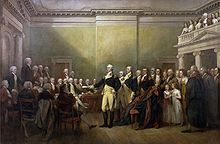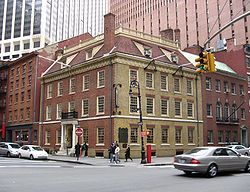Cross posted from The Stars Hollow Gazette
This is your morning Open Thread. Pour your favorite beverage and review the past and comment on the future.
Find the past “On This Day in History” here.
December 6 is the 340th day of the year (341st in leap years) in the Gregorian calendar. There are 25 days remaining until the end of the year.
On this day in 1884, the Washington Monument is completed.
In Washington, D.C., workers place a nine-inch aluminum pyramid atop a tower of white marble, completing the construction of an impressive monument to the city’s namesake and the nation’s first president, George Washington. As early as 1783, the infant U.S. Congress decided that a statue of George Washington, the great Revolutionary War general, should be placed near the site of the new Congressional building, wherever it might be. After then-President Washington asked him to lay out a new federal capital on the Potomac River in 1791, architect Pierre L’Enfant left a place for the statue at the western end of the sweeping National Mall (near the monument’s present location).
The Washington Monument is an obelisk near the west end of the National Mall in Washington, D.C., built to commemorate the first U.S. president, General George Washington. The monument, made of marble, granite, and sandstone, is both the world’s tallest stone structure and the world’s tallest obelisk, standing 555 feet 5 1/8 inches (169.294 m). There are taller monumental columns, but they are neither all stone nor true obelisks. It is also the tallest structure in Washington D.C.. It was designed by Robert Mills, an architect of the 1840s. The actual construction of the monument began in 1848 but was not completed until 1884, almost 30 years after the architect’s death. This hiatus in construction happened because of co-option by the Know Nothing party, a lack of funds, and the intervention of the American Civil War. A difference in shading of the marble, visible approximately 150 feet (46 m or 27%) up, shows where construction was halted for a number of years. The cornerstone was laid on July 4, 1848; the capstone was set on December 6, 1884, and the completed monument was dedicated on February 21, 1885. It officially opened October 9, 1888. Upon completion, it became the world’s tallest structure, a title previously held by the Cologne Cathedral. The monument held this designation until 1889, when the Eiffel Tower was completed in Paris, France. The monument stands due east of the Reflecting Pool and the Lincoln Memorial.




 Marlon Brando‘s famous cry of “STELLA!” first booms across a Broadway stage, electrifying the audience at the Ethel Barrymore Theatre during the first-ever performance of Tennessee Williams‘ play A Streetcar Named Desire.
Marlon Brando‘s famous cry of “STELLA!” first booms across a Broadway stage, electrifying the audience at the Ethel Barrymore Theatre during the first-ever performance of Tennessee Williams‘ play A Streetcar Named Desire. An energy-trading company based in Houston, Texas, Enron was formed in 1985 as the merger of two gas companies, Houston Natural Gas and Internorth. Under chairman and CEO Kenneth Lay, Enron rose as high as number seven on Fortune magazine’s list of the top 500 U.S. companies. In 2000, the company employed 21,000 people and posted revenue of $111 billion. Over the next year, however, Enron’s stock price began a dramatic slide, dropping from $90.75 in August 2000 to $0.26 by closing on November 30, 2001.
An energy-trading company based in Houston, Texas, Enron was formed in 1985 as the merger of two gas companies, Houston Natural Gas and Internorth. Under chairman and CEO Kenneth Lay, Enron rose as high as number seven on Fortune magazine’s list of the top 500 U.S. companies. In 2000, the company employed 21,000 people and posted revenue of $111 billion. Over the next year, however, Enron’s stock price began a dramatic slide, dropping from $90.75 in August 2000 to $0.26 by closing on November 30, 2001.
 On this day in 1886,
On this day in 1886,  It opened on 2 May 1869 as the Folies Trévise, with fare including operettas, comic opera, popular songs, and gymnastics. It became the Folies Bergère on 13 September 1872, named after a nearby street, the rue Bergère (the feminine form of “shepherd”).
It opened on 2 May 1869 as the Folies Trévise, with fare including operettas, comic opera, popular songs, and gymnastics. It became the Folies Bergère on 13 September 1872, named after a nearby street, the rue Bergère (the feminine form of “shepherd”). On this day in 1963, one week after President John F. Kennedy was fatally shot while riding in a motorcade in Dallas, Texas, President Lyndon Johnson establishes a
On this day in 1963, one week after President John F. Kennedy was fatally shot while riding in a motorcade in Dallas, Texas, President Lyndon Johnson establishes a 


